[ezcol_1half]Beginning in the late 19th Century, tens of thousands of Lithuanians immigrated to the United States. Though Americanized, and many second generation, most still looked to Lithuania as their homeland in 1930.
Like other Americans, they were swept up in “Atlantic Fever,” the efforts to fly the Atlantic.

Scott C79-84
As it happened, two Lithuanian-Americans had purchased a plane and were preparing to hop the Atlantic.
Steponas Darius and Stasys Girėnas had immigrated to the United States as children with their families. Both had fought in World War I with the U.S. Army.
After the war, Darius went to Lithuania and joined the Army. He graduated from military school in 1921 and participated in the seizure of the former German city of Memel (now Klaipėda) in 1923. He also trained as a pilot.
After returning to the United States, he helped form South Bend Airways, before moving to Chicago.
Girėnas, meanwhile, had left the Army after WWI. He learned to fly, and bought an aircraft in 1925. In 1931, he won a prize at the Chicago Air Festival for landing his plane with the engine off.
The two teamed up to buy a Bellanca, then the favorite aircraft for trans-Atlantic attempts. It was the depths of the Depression, but the Lithuanian-American community raised money for the flight. The plane, named the Lituanica, was extensively modified for the flight, but carried neither a radio nor parachutes.
The pilots flew to Floyd Bennett Field in Brooklyn in 1933. But the U.S. government was slow to issue permits to land in European countries. Rather than continue to wait, they told authorities on July 15, 1933, that they were going for a test flight. The heavily laden plane barely made it into the air, lifting off just 50 feet from Jamaica Bay.
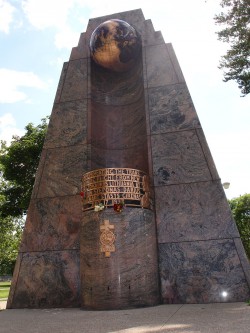
Darius and Girėnas monument, Marquette Park, Chicago
Their goal was Kaunas, then the capital of Lithuania. The trip required precise navigation, which Darius and Girėnas managed. But after flying 37 hours, and only three hours from Kaunas, disaster struck. The plane crashed after midnight near the German town of Soldin (now Pszczelnik, in Poland). Both pilots were killed.
A Lithuanian board went to the crash site to investigate. It concluded that weather and engine problems probably caused a forced landing. It said the plane had plenty of fuel.
However, on the night of the crash, Germans reported a plane flying in circles, apparently lost. American aviator Wiley Post, who was also flying in the area at the time, reported hitting a thunderstorm. His instruments were knocked out, forcing him to land at Königsberg, then a large German city in East Prussia.
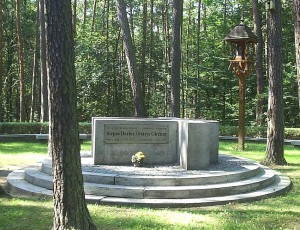
Monument to Darius and Girėnas, near Pszczelnik, Poland
Source: Jan Jerszyński
German authorities theorized that Darius and Girėnas had reached Königsberg. But they may not have known where they were, and doubled back. The Germans believed that the plane had run out of fuel. Indeed, the New York Times reported July 18 that the fuel tanks were dry.
A conspiracy theory later arose, that the plane had been shot down by the Germans. However, no wounds were found on the pilots’ bodies. No evidence has surfaced to support the conspiracy theory.
As the time for the arrival neared, an excited crowd had gathered in Kaunas. But the hours passed, and the plane did not arrive. Residents eventually realized something terrible had happened.
The remains of Darius and Girėnas were flown to Kaunas. The nation was devastated by the loss of the pilots. They were given a state funeral; 40,000 people attended.
Lithuania issued a set of six airmail mourning stamps, Scott C79-84, in 1934.
[/ezcol_1half] [ezcol_1half_end]
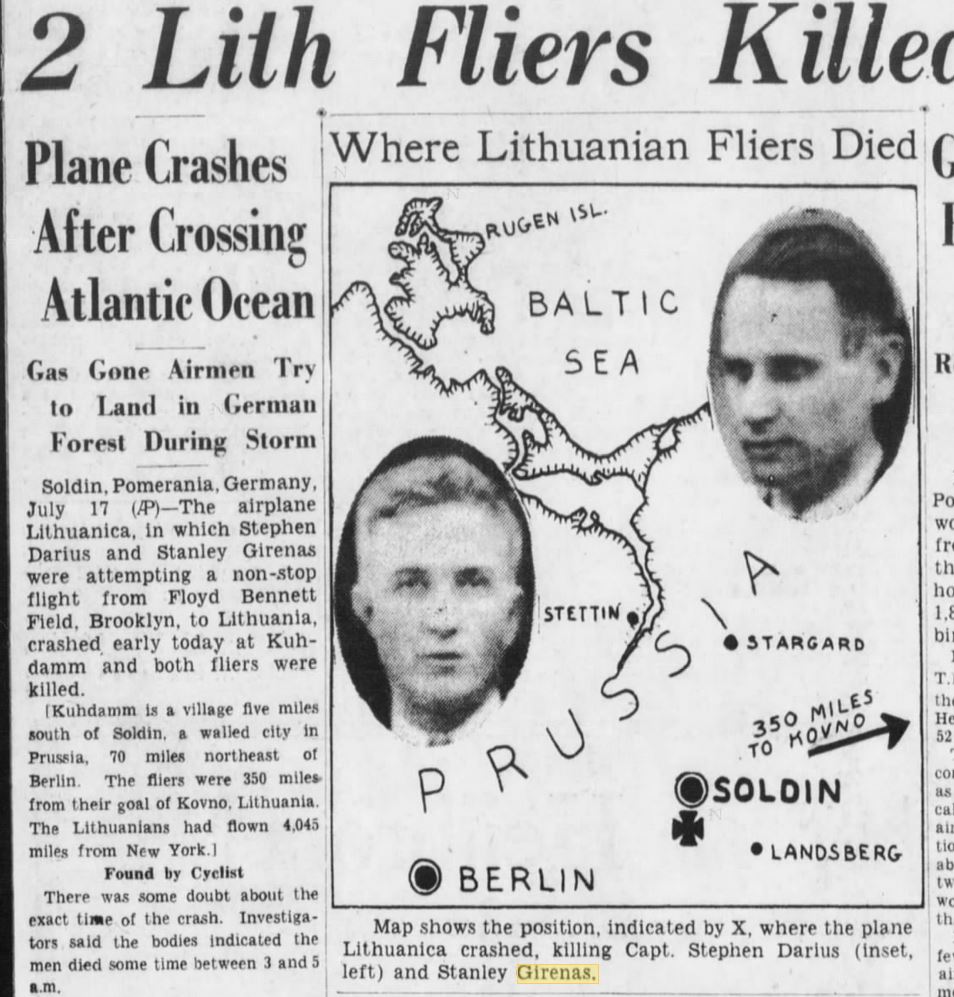
Brooklyn Daily Eagle, Page 1; July 17, 1933
Within months, Lithuanian-Americans were discussing another flight. Despite the privations of the Depression, they raised money for a Lockheed Vega. Post had used a Vega in his round-the-world flight, as had Amelia Earhart when she crossed the Atlantic.
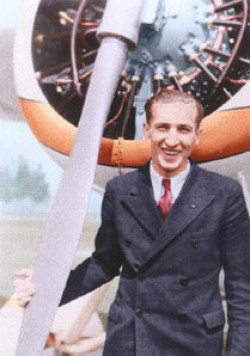
Felix Vaitkus
The plane was christened Lituanica II on April 22, 1934. The organizers asked Felix Vaitkus (also known as Feliksas Vaitkus and Felix Waitkus) to pilot the aircraft.
Vaitkus was born in 1907 in Chicago, a second-generation Lithuanian-American. He joined the Army in 1928, and graduated from flight school. He was placed in the reserves as a first lieutenant in 1931.
The Lituanica II underwent extensive modifications in 1934 and ’35. A variable pitch propeller and a radio compass, neither of which the original Lituanica had, were added. The plane was tested extensively, and by May of 1935, Vaitkus was ready. He traveled to Floyd Bennett Field, the jumping-off point used by Darius and Girėnas.

Vaitkus and his Lockheed Vega
Source: Lietuvos Aviacijos Istorija 1919 – 1940 m.
Weather was bad for most of the summer. But he was told on Sept. 20 that the weather to Europe was good, and he took off. The weather report was wrong; Vaitkus fought bad conditions most of the way to Europe. Approaching Europe, he was receiving hourly weather reports from a Dublin radio station.
Vaitkus said later that his fuel consumption was much greater than expected. He had planned to land in Dublin and refuel. But he ran into a mist over Ireland, and decided to put the plane down.
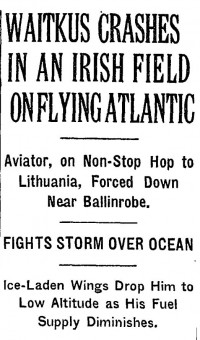
New York Times, Page 1; Sept. 23, 1935
Vaitkus landed in a field near the town of Ballinrobe, Ireland. The plane was seriously damaged, but Vaitkus was unhurt. Nearby villagers took him to the cottage of Paddy Walsh, where they prepared breakfast for him. He then bicycled to Ballinrobe and reported to the police.
The wreckage was bundled up and shipped to Lithuania. Vaitkus awaited his wife in London, than traveled to Kaunas via commercial air. The sixth flier to cross the Atlantic solo, he was hailed as a hero.
Lithuania issued three stamps in 1936 (Scott C85-87) to honor Vaitkus. Two other stamps showed up under less official circumstances. They are Sanabria 128 and 129, which appeared in 1935. Sanabria 129 was never issued, although one copy is known to have been used postally, according to Sanabria. Both stamps are footnoted in Scott. The five stamps are shown above the headline.
Vaitkus returned to the United States. In 1940, he was recalled to active duty by the Army Air Corps. He served as the chief test pilot of Boeing Aircraft Co. throughout World War II, flying hundreds of B-17 and B-29 bombers. Vaitkus died of a heart attack in 1956, age 49. He was still in the Air Force, with the rank of lieutenant colonel.
Lithuania built a mausoleum for Darius and Girėnas. It was destroyed after the Soviet Union seized the country in 1940. Their bodies now rest in a military cemetery in Kaunas.
The wreckage of the Lituanica is displayed in the Vytautas the Great War Museum in Kaunas.
In 1935, the Lithuanian-American community raised money for a memorial to Darius and Girėnas. It was placed in a corner of Marquette Park, in what was then a Lithuanian neighborhood. A monument was also raised in New York City.
The crash site in Poland has a marker, as does Lithuania.
The town of Ballinrobe, in Ireland, has not forgotten Vaitkus. It erected a monument to the flier in 2007. In its years as the Celtic Tiger, Ireland attracted Lithuanian workers. Many made pilgrimages to Ballinrobe to remember their aviator.
Sources: New York Times, Brooklyn Daily Eagle, Wikipedia, BallinrobeLithuania.com
[/ezcol_1half_end]




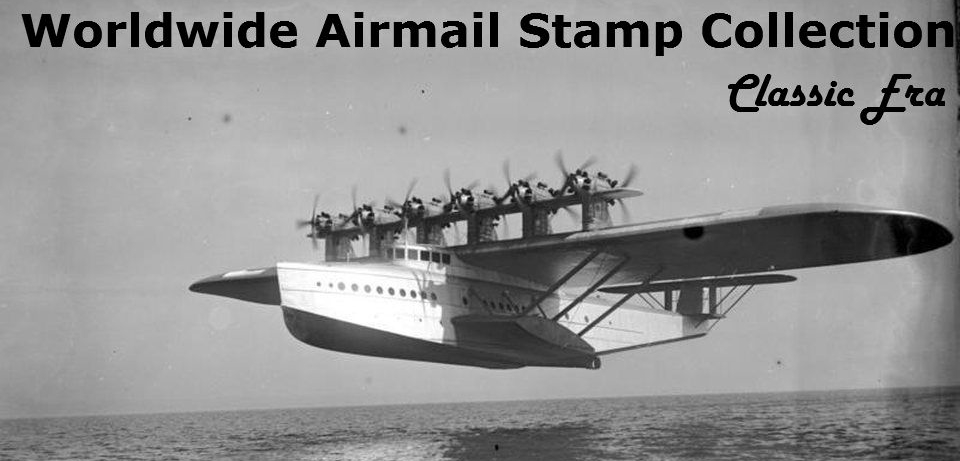
 ‘Atlantic Fever’ and the Lithuanian fliers
‘Atlantic Fever’ and the Lithuanian fliers